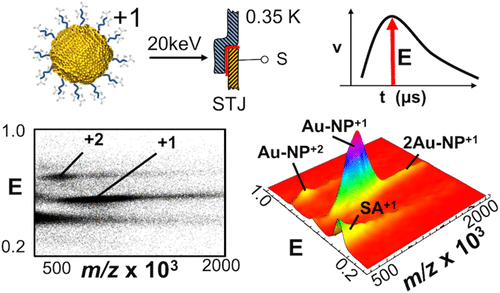Our official English website, www.x-mol.net, welcomes your
feedback! (Note: you will need to create a separate account there.)
Characterization of Mega-Dalton-Sized Nanoparticles by Superconducting Tunnel Junction Cryodetection Mass Spectrometry
ACS Nano ( IF 15.8 ) Pub Date : 2018-02-26 00:00:00 , DOI: 10.1021/acsnano.7b08541 David M. Sipe 1 , Logan D. Plath 1 , Alexander A. Aksenov 1 , Jonathan S. Feldman 1 , Mark E. Bier 1
ACS Nano ( IF 15.8 ) Pub Date : 2018-02-26 00:00:00 , DOI: 10.1021/acsnano.7b08541 David M. Sipe 1 , Logan D. Plath 1 , Alexander A. Aksenov 1 , Jonathan S. Feldman 1 , Mark E. Bier 1
Affiliation

|
The characterization of nanomaterials is critical to understand the size/structure-dependent properties of these particles. In this report, a form of heavy ion mass spectrometry, namely, superconducting tunnel junction (STJ) cryodetection mass spectrometry (MS) is used to characterize quantum dot semiconductor nanocrystals and gold nanoparticles. The nanoparticles studied ranged in mass from 200 kDa to >1.5 MDa and included lead sulfide quantum dots, various cadmium selenide and/or telluride-based core–shell quantum dots coated with different ligands, and gold nanoparticles. Nanoparticles were ionized by both matrix-assisted laser desorption ionization (MALDI) and laser desorption ionization (LDI), shot with an aimed ion gun into a flight tube, mass separated by time-of-flight (TOF), and detected by an energy-sensitive STJ cryodetector. STJ cryodetection MS can be used to analyze intact heterogeneous nanoparticles, allowing determination of average particle mass, dispersity, and ligand loading. Some nanoparticles, however, do undergo fragmentation during the MALDI or LDI-TOF mass analyses. The measurement of the energy deposited into the detector was found to be different for different types of particles. Metastable fragments from these nanoparticles were observed at lower energies. The lower energies deposited for metastable fragments can provide insight into the stability and surface compositions of these materials. Cadmium selenide core–shell quantum dots (655 nm emission) conjugated to biomacromolecules, such as cholera toxin B and human serum transferrin, were also analyzed. When compared to unconjugated particles by mass, it was determined that ∼96 cholera toxin B and ∼14 transferrin proteins were attached to the surface of these nanoparticles.
中文翻译:

超导隧道结低温检测质谱法表征兆尔顿级纳米颗粒
纳米材料的表征对于理解这些颗粒的尺寸/结构相关特性至关重要。在此报告中,一种重离子质谱法即超导隧道结(STJ)低温检测质谱(MS)用于表征量子点半导体纳米晶体和金纳米颗粒。研究的纳米粒子的质量范围从200 kDa到> 1.5 MDa,包括硫化铅量子点,涂有不同配体的各种硒化镉和/或碲化物基核-壳量子点,以及金纳米粒子。纳米粒子通过基质辅助激光解吸电离(MALDI)和激光解吸电离(LDI)进行电离,用瞄准离子枪射入飞行管,通过飞行时间(TOF)分离质量,并通过能量检测敏感的STJ低温探测器。STJ低温检测质谱仪可用于分析完整的异质纳米颗粒,从而确定平均颗粒质量,分散度和配体负载。但是,某些纳米粒子会在MALDI或LDI-TOF质量分析过程中发生断裂。发现沉积到检测器中的能量的测量对于不同类型的粒子是不同的。在较低的能量下观察到了来自这些纳米颗粒的亚稳态碎片。为亚稳碎片沉积的较低能量可以提供对这些材料的稳定性和表面组成的了解。还分析了与生物大分子(例如霍乱毒素B和人血清转铁蛋白)结合的硒化镉核壳量子点(发射655 nm)。与非共轭颗粒的质量相比,
更新日期:2018-02-26
中文翻译:

超导隧道结低温检测质谱法表征兆尔顿级纳米颗粒
纳米材料的表征对于理解这些颗粒的尺寸/结构相关特性至关重要。在此报告中,一种重离子质谱法即超导隧道结(STJ)低温检测质谱(MS)用于表征量子点半导体纳米晶体和金纳米颗粒。研究的纳米粒子的质量范围从200 kDa到> 1.5 MDa,包括硫化铅量子点,涂有不同配体的各种硒化镉和/或碲化物基核-壳量子点,以及金纳米粒子。纳米粒子通过基质辅助激光解吸电离(MALDI)和激光解吸电离(LDI)进行电离,用瞄准离子枪射入飞行管,通过飞行时间(TOF)分离质量,并通过能量检测敏感的STJ低温探测器。STJ低温检测质谱仪可用于分析完整的异质纳米颗粒,从而确定平均颗粒质量,分散度和配体负载。但是,某些纳米粒子会在MALDI或LDI-TOF质量分析过程中发生断裂。发现沉积到检测器中的能量的测量对于不同类型的粒子是不同的。在较低的能量下观察到了来自这些纳米颗粒的亚稳态碎片。为亚稳碎片沉积的较低能量可以提供对这些材料的稳定性和表面组成的了解。还分析了与生物大分子(例如霍乱毒素B和人血清转铁蛋白)结合的硒化镉核壳量子点(发射655 nm)。与非共轭颗粒的质量相比,











































 京公网安备 11010802027423号
京公网安备 11010802027423号